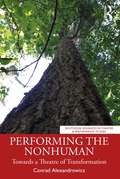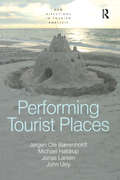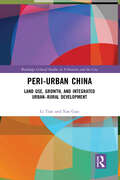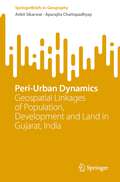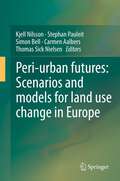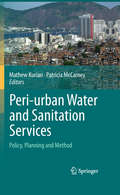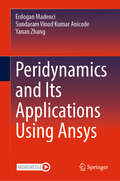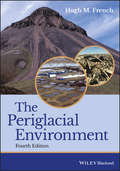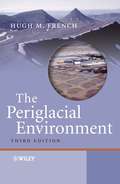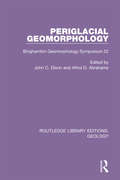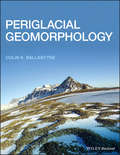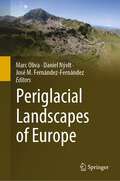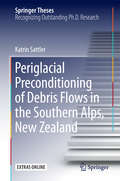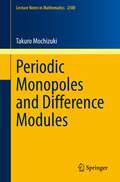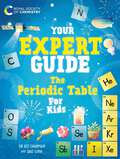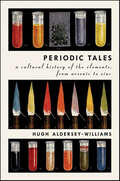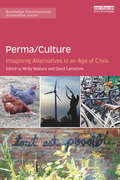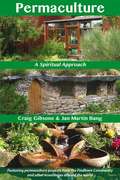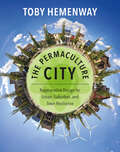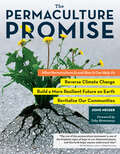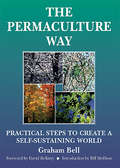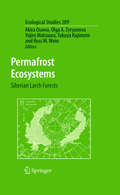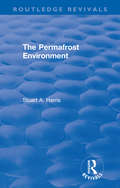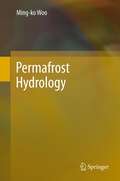- Table View
- List View
Performing the Nonhuman: Towards a Theatre of Transformation (ISSN)
by Conrad AlexandrowiczThis book radically reimagines theatre/performance pedagogy and dramaturgy in response to the accelerating climate crisis.This text is founded upon the principle that the theatre is the most anthropocentric of all the arts: the means of its representation, the human figure, is identical with its conventional object, the human narrative, broadly considered. In order to respond ethically to the climate crisis, it must expand its range to include performing as/in response to the nonhuman. Conrad Alexandrowicz concisely explores theoretical approaches to the other‑than‑human, found in the work of, among others, Jane Bennett, Timothy Morton, Rosi Braidotti, and Cary Wolfe. The implications of this move are far‑reaching and commence with displacing realism from its traditional position of dominance. The practices of 20th century physical theatre visionaries such as Tadeusz Kantor, Jacques Lecoq, and Jerzy Grotowski are revisited and reconsidered for their applicability to forms of theatre that might serve the needs of establishing storytelling deriving from nonhuman phenomena. This logically leads to the matter of responding appropriately to Indigenous ways of knowing and being. The work finds guidance in Indigenous, pre‑scientific ways of knowing and being, such as those articulated by Robin Wall Kimmerer (Braiding Sweetgrass, 2013). In contemplating our kinship with vegetative life, the work finds inspiration in the latest research into the ways tree communities communicate, collaborate, and share resources, including the work of Suzanne Simard (Finding the Mother Tree, 2021). It next imagines transformations in how theatre is situated, delivered, and received and considers the ways in which the performer/spectator binary may have to be reconfigured, with particular reference to Grotowski’s experiments in participatory theatre. It poses an even more provocative question: is such theorized performance work pointing in the direction of some re‑imagined version of ritual and ceremony that may find antecedents in pre‑Christian European belief and practice? Finally, it locates such eco‑theatre in the realm of healing: climate anxiety, depression, and grief on the part of instructors, students, and artists will require us to consider and activate the healing power of the art form; perhaps, the core purpose of all the arts will shift to support the need to generate solace in times of fear, anger, and uncertainty.This book is intended for instructors, both scholars and performance pedagogues, in theatre and performance studies, as well as graduate and undergraduate students in these areas.
Performing Tourist Places (New Directions in Tourism Analysis)
by John Urry Jørgen Ole Bærenholdt Michael HaldrupThis book looks at the making and the consuming of places in the contemporary world. Illustrated through various case-studies from Denmark, it considers how places, performances and peoples intersect. It examines the fascinating circumstances through which visitors to a place, in part, produce that place through their performances. Places are intertwined with people through various systems that generate and reproduce performances in and of that place. These systems comprise networks of ’hosts, guests, buildings, objects and machines’ that contingently realize particular performances of specific places. The studies featured here develop an exciting ’new mobility’ paradigm emerging within the social sciences.
Peri-Urban China: Land Use, Growth, and Integrated Urban–Rural Development (Routledge Critical Studies in Urbanism and the City)
by Yan Guo Li TianThe urban-rural relationship in China is key to a sustainable global future. This book is particularly interested in peri-urbanization in China, the process by which fringe areas of cities develop. Recent institutional change has helped clarify property rights over collective land, facilitating peri-urban area development. Chapters in this book explore how rural industrialization has changed the landscape and rules about land use in peri-urban areas. It looks at the role of rural industrialization and provides a detailed exploration of peri-urbanization theory, policy, and its evolution in China. Leading discussions find out how fragmented bottom-up industrialization, urbanization, and lax governance have led to a series of social and environmental problems. The progress in redevelopment of peri-urban areas was initially slow due to the spatial lock-in effect. This book offers practical solutions to environmental issues and explains how policymakers have the potential to redevelop a future collaborative, inclusive, and sustainable approach to peri-urban areas. This in-depth approach to urbanization will be useful to academics in urban planning and governmental organizations. It will also be advantageous to NGOs and professionals involved in urban planning, public administration, as well as land-use work in China and other developing countries.
Peri-Urban Dynamics: Geospatial Linkages of Population, Development and Land in Gujarat, India (SpringerBriefs in Geography)
by Ankit Sikarwar Aparajita ChattopadhyayUrban expansion beyond the city’s administrative boundaries has altered villages to a great extent. These peri-urban villages are experiencing unforeseen changes in demographic, economic, land-use, and environmental characteristics. The concept of peri-urbanization is grabbing the attention of urban planners and policymakers globally. To understand the dynamics of the peri-urban region it is crucial to examine multiple rural and urban characteristics. This book studies major changes in population, land and development with the integration of remotely sensed data and census data for 615 peri-urban villages surrounding Ahmedabad city of India. The chapters of the book are designed to cover key aspects of peri-urban change with geospatial methods. This book offers a comprehensive understanding and importance of analyzing peri-urban dynamics at the smallest spatial unit. It provides a detailed conceptual and methodological framework for the students and researchers to study peri-urbanization as well as for the policymakers to redefine the urban policies.
Peri-urban futures: Scenarios and models for land use change in Europe
by Carmen Aalbers Kjell Nilsson Simon Bell Stephan Pauleit Thomas A. Sick NielsenPresently, peri-urbanisation is one of the most pervasive processes of land use change in Europe with strong impacts on both the environment and quality of life. It is a matter of great urgency to determine strategies and tools in support of sustainable development. The book synthesizes the results of PLUREL, a large European Commission funded research project (2007-2010). Tools and strategies of PLUREL address main challenges of managing land use in peri-urban areas. These results are presented and illustrated by means of 7 case studies which are at the core of the book. This volume presents a novel, future oriented approach to the planning and management of peri-urban areas with a main focus on scenarios and sustainability impact analysis. The research is unique in that it focuses on the future by linking quantitative scenario modeling and sustainability impact analysis with qualitative and in-depth analysis of regional strategies, as well as including a study at European level with case study work also involving a Chinese case study.
Peri-urban Water and Sanitation Services
by Mathew Kurian Patricia MccarneyMore than 2.6 billion people in the developing world lack access to safe water and sanitation service. The Millennium Development Goal's (MDG) target is to halve the number of people without access to a sustainable source of water supply and connection to a sewer network by 2015. That target is unlikely to be met. If there is anything that can be learnt from European experience it is that institutional reform occurs incrementally when politically enfranchised urban populations perceive a threat to their material well-being due to contamination of water sources.
Peridynamics and Its Applications Using Ansys
by Yanan Zhang Erdogan Madenci Sundaram Vinod AnicodeThis book introduces a unified implementation of bond- and state-based peridynamic theory (PD) within a commercial finite element framework, Ansys, utilizing its native elements. It details the implementation of the PD theory and its integration with traditional finite elements. The primary objective is to equip students, researchers, and practicing engineers with both theoretical and practical knowledge of the PD theory, along with the skills necessary for analyzing engineering problems using Ansys. The book demonstrates that, unlike the conventional finite element method (FEM), the PD theory is highly suitable for progressive failure analysis, the multi-scale analysis of materials involving fracture and failure, and multi-physics analysis, including electromigration, corrosion, and electrodeposition. Additionally, it provides a step-by-step illustration of the specific procedures in the pre-processing, solution, and post-processing phases of the analysis through the Graphical User Interface (GUI) for various applications. The book is designed to be introductory and self-contained, minimizing the need for additional reference material.
The Periglacial Environment
by Hugh M. FrenchThe Periglacial Environment, Fourth Edition, is an authoritative overview of the world’s cold, non-glacial environments. First published in 1976 and subsequently revised in 1996 and 2007, the text has been the international standard for nearly 40 years. The Fourth Edition continues to be a personal interpretation of the frost-induced conditions, geomorphic processes and landforms that characterize periglacial environments. Part One discusses the periglacial concept and describes the typical climates and ecosystems that are involved. Part Two describes the geocryology (permafrost science) associated with frozen ground. Part Three outlines the weathering and geomorphic processes associated with cold-climate conditions. Part Four provides insight into the periglacial environments of the Quaternary, especially the Late Pleistocene. Part Five describes some of the problems associated with human occupancy in regions that experience frozen ground and cold-climate conditions. Extensively revised and updated Written by an expert with over 50 years of field research Draws upon the author’s personal experience from Northern Canada, Alaska, Siberia, Tibet, Antarctica, Svalbard, Scandinavia, southern South America, Western Europe and eastern North America This book is an invaluable reference for advanced undergraduates in geography, geology, earth sciences and environmental sciences programs, and to resource managers and geotechnical engineers interested in cold regions.
The Periglacial Environment
by Hugh M. FrenchThe Periglacial Environment, Third Edition, provides an authoritative overview of the world???s cold, non-glacial environments. Emphasis is placed upon the North American and Eurasian polar lowlands, but examples are also drawn from Antarctica, the Qinghai-Xizang (Tibet) Plateau, and the northern mid-latitudes. First published in 1976 and subsequently revised in 1996, the text has been the international standard for??over 30 years.The Third Edition continues to be a personal interpretation of the frost-induced conditions, geomorphic processes, and landforms that typify periglacial environments. The text is divided into four parts. Part One discusses the periglacial concept and its interactions with geomorphology, geocryology and Quaternary science. It also outlines the range and variability of periglacial climates and the degree to which??landscapes are in geomorphic equilibrium with prevailing periglacial conditions. Part Two describes present-day terrain that is either underlain by permafrost or experiencing intense frost action. The roles played by cryogenic weathering, ground ice, mass wasting, running water, wind action, snow and ice, and coastal processes are systematically analysed. Part Three summarizes evidence for the existence of periglacial conditions during the cold periods of the Pleistocene, with special reference to the mid-latitudes of Europe and North America. Part Four illustrates the geotechnical problems associated with human activity and resource development in periglacial environments, and discusses the potential impact of global climate change in the northern high latitudes.This excellent textbook is an invaluable resource for second and third year undergraduate students of Physical Geography, Geology, Environmental Science and Earth Science. The Periglacial Environment, Third Edition is also an??informative reading for professionals, researchers and lecturers working and teaching in the field.
Periglacial Geomorphology: Binghamton Geomorphology Symposium 22 (Routledge Library Editions: Geology #25)
by Abrahams John C. Dixon Athol D.This book, first published in 1992, contains the proceedings of the 22nd Binghamton Geomorphology Symposium, and highlights the quantity and diversity of periglacial geomorphic research being undertaken in Arctic and alpine environments. The articles explore a variety of geomorphic processes and examine the potential impacts of global change on the nature and extent of permafrost and seasonal ice phenomena.
Periglacial Geomorphology
by Colin K. BallantyneA fascinating and informative exploration of periglacial processes, past and present, and their role in landscape evolution Periglacial Geomorphology presents a comprehensive introduction to the processes that operate in present periglacial environments and discusses the inferences that can be drawn about former periglacial environments from those processes. Organized into six parts, the book opens with the historical and scientific context of periglacial geomorphology and the nature of periglacial environments. Following chapters provide systematic coverage of the full range of topics germane to a thorough understanding of periglacial geomorphology, including: The physics of ground freezing and thawing, characteristics of permafrost, and the nature and origin of underground ice Characteristics, formation and significance of landforms, sediments, and structures associated with permafrost, permafrost degradation, and seasonal ground freezing and thawing Rock weathering in periglacial environments, periglacial processes operating on hillslopes, and the characteristic landforms produced by rock breakdown and slope processes in cold environments The operation of fluvial, aeolian and coastal processes in cold environments, and the resulting distinctive landforms and sediments The use of relict periglacial features to reconstruct past cold environments in midlatitude regions and the responses of periglacial environments to recent and predicted climate change Periglacial Geomorphology is an important resource for undergraduate and graduate students studying geomorphology or Quaternary science within the context of geography and geology degree programs. It will be of use to all scientists whose research involves an understanding of cold environments, whether from a geographical, geological, ecological, climatological, pedological, hydrological, or engineering perspective.
Periglacial Landscapes of Europe
by Marc Oliva Daniel Nývlt José M. Fernández-FernándezThis book comprehensively presents the geography of landforms linked to periglacial processes across Europe. The landscape of the European cold climate regions, both at high latitudes and in mountainous environments, represent the lingering, minimal expression of the glaciers. In addition, periglacial elements can be found in temperate regions, where temperatures no longer favor periglacial processes, so landforms are therefore inherited from previous cold phases.The book is divided into five parts: an introductory section on climate variability responsible for periglacial dynamics across Europe; a second part including 3 blocks on periglacial landforms in southern, central and northern Europe; and a final chapter providing a more general perspective on the impact of periglacial processes on the landscape of Europe. The book offers a valuable reference guide for scientists from all disciplines interested in cold climate processes, as well as readers outside academia (territorial managers, environmentalists, mountaineers, politicians, engineers, etc.).
Periglacial Preconditioning of Debris Flows in the Southern Alps, New Zealand
by Katrin SattlerThis thesis represents one of the few studies so far that systematically analyses environmental conditions within debris flow source areas to determine their relative importance for debris flow development. Environmental site conditions, such as slope gradient and debris availability, influence the spatial and temporal distribution of debris flows in high-alpine areas. However, current understanding of these preconditioning controls is mostly qualitative and inadequate for debris-flow hazard assessments and climate change impact studies. The author's research investigates the role of frost weathering and permafrost in the occurrence of debris flows in the Southern Alps of New Zealand. Analyses are based on an extensive debris flow inventory, documenting debris flow occurrence and activity over the last 60 years in selected catchments. Debris flow activity is compared to frost-weathering intensity estimates from two models, allowing the practical comparison of two competing frost-weathering hypotheses currently discussed in literature. Information on permafrost occurrence is based on a new distributed permafrost estimate for the Southern Alps, derived from climatic conditions at active rock glacier sites. This pioneering thesis provides empirical evidence that frost weathering promotes debris-flow formation. It further highlights the potential and limitations of regional-scale studies for advancing our understanding of debris-flow preconditioning factors.
Periodic Monopoles and Difference Modules (Lecture Notes in Mathematics #2300)
by Takuro MochizukiThis book studies a class of monopoles defined by certain mild conditions, called periodic monopoles of generalized Cherkis–Kapustin (GCK) type. It presents a classification of the latter in terms of difference modules with parabolic structure, revealing a kind of Kobayashi–Hitchin correspondence between differential geometric objects and algebraic objects. It also clarifies the asymptotic behaviour of these monopoles around infinity.The theory of periodic monopoles of GCK type has applications to Yang–Mills theory in differential geometry and to the study of difference modules in dynamical algebraic geometry. A complete account of the theory is given, including major generalizations of results due to Charbonneau, Cherkis, Hurtubise, Kapustin, and others, and a new and original generalization of the nonabelian Hodge correspondence first studied by Corlette, Donaldson, Hitchin and Simpson.This work will be of interest to graduate students and researchers in differential and algebraic geometry, as well as in mathematical physics.
The Periodic Table for Young Scientists (Your Expert Guide #1)
by Dr Dr Kit ChapmanFrom a top expert in the world of science comes this definitive guide to the Periodic Table, published in partnership with the Royal Society of Chemistry.In Your Expert Guide: The Periodic Table, discover the origins and genius of the Periodic Table: how the idea came about, what each symbol means and how it underpins our understanding of matter, materials and the study of chemistry. Explore the elements at work in our world and get a clear picture of the Periodic Table's role in explaining the building blocks of the Universe.Written by Dr Kit Chapman, award-winning science journalist, academic at Falmouth University and global science communicator. Published in partnership with The Royal Society of Chemistry, the internationally renowned nonprofit organisation with the same mission since 1841: to advance excellence in the chemical sciences. With lovely artwork by Dao Linh, see the elements come alive for curious readers aged 8+.Books in the Your Expert Guide series:With the Royal Society of Chemistry: The Periodic Table and Chemistry for Young ScientistsWith the Royal Society of Biology: The Human Body and Biology for Young ScientistsWith the Institute of Physics: The Universe for Kids and Physics for Young Scientists
Periodic Tales: A Cultural History of the Elements, from Arsenic to Zinc
by Hugh Aldersey-WilliamsIn the spirit of A Short History of Nearly Everything comes Periodic Tales. Award-winning science writer Hugh Andersey-Williams offers readers a captivating look at the elements—and the amazing, little-known stories behind their discoveries. Periodic Tales is an energetic and wide-ranging book of innovations and innovators, of superstition and science and the myriad ways the chemical elements are woven into our culture, history, and language. It will delight readers of Genome, Einstein’s Dreams, Longitude, and The Age of Wonder.
Perishability Fatigue: Forays Into Environmental Loss and Decay (Critical Life Studies)
by Vincent BruyereThe Svalbard Global Seed Vault project is an arctic archive designed to preserve the world’s agricultural biodiversity. What do it and other novel forms of storage tell us about our relationship to the future in a time of resource depletion and extinction scenarios? In this innovative book, Vincent Bruyere offers an invitation to look at the present we live in through a fresh lens: the difference between storage and burial in the age of sustainability science.Perishability Fatigue considers questions of permanence and the potentiality of retrieval, noting the tensions within our collective sense of time and finitude. Bruyere reflects on the nature and significance of perishability, asking what it means to have one’s sense of temporality engendered by seed banks and frozen embryo storage, genetically modified organisms and the “de-extinction” of species, nuclear-waste repositories, oncology, and palliative care. He draws attention to the scripts and scenarios that mediate our relations to loss and decay, preservation and conservation, emphasizing the inequalities implicit in technologies of perishability, which promise continuity in the future to some while refusing it to others. A highly interdisciplinary study, Perishability Fatigue reframes the environmental humanities and humanistic inquiry into sustainability science by developing a new language to commemorate fatigue and transience in a culture of preparedness and survival.
Perma/Culture: Imagining Alternatives in an Age of Crisis (Routledge Environmental Humanities)
by Molly Wallace and David CarruthersIn the face of what seems like a concerted effort to destroy the only planet that can sustain us, critique is an important tool. It is in this vein that most scholars have approached environmental crisis. While there are numerous texts that chronicle contemporary issues in environmental ills, there are relatively few that explore the possibilities and practices which work to avoid collapse and build alternatives. The keyword of this book’s full title, 'Perma/Culture,' alludes to and plays on 'permaculture', an international movement that can provide a framework for navigating the multiple 'other worlds' within a broader environmental ethic. This edited collection brings together essays from an international team of scholars, activists and artists in order to provide a critical introduction to the ethico-political and cultural elements around the concept of ‘Perma/Culture’. These multidisciplinary essays include a varied landscape of sites and practices, from readings from ecotopian literature to an analysis of the intersection of agriculture and art; from an account of the rewards and difficulties of building community in Transition Towns to a description of the ad hoc infrastructure of a fracking protest camp. Offering a number of constructive models in response to current global environmental challenges, this book makes a significant contribution to current eco-literature and will be of great interest to students and researchers in Environmental Humanities, Environmental Studies, Sociology and Communication Studies.
Permaculture: A Spiritual Approach
by Craig Gibsone Jan Martin BangPermaculture design as divine creative activity. Permaculture looks for the patterns embedded in our natural world as inspirations for designing solutions to the many challenges we are presented with today. It is a philosophical, spiritual and practical approach to the use of the land, integrating microclimate, functional plants, animals, soils, water management and human needs into intricately connected, highly productive systems. In essence, permaculture uses observation as basis for creating sustainable and effective human settlements. The authors discuss the components Earthshare, Fairshare and Peoplecare, with a specific emphasis on the spiritual aspects of the design process. Topics range from soil and plants, energy sources and house design to alternative economics, group process, governance, and spiritual nurturing and enquiry. Examples of existing permaculture structures from around the world, most notably from the Findhorn Community Eco-Village, bring the concepts to life. First-hand accounts of how people got started on their permaculture project lend a personal touch. The first book to look at the spiritual aspects as well as the practical implementation of permaculture design.
The Permaculture City: Regenerative Design for Urban, Suburban, and Town Resilience
by null Toby HemenwayPermaculture is more than just the latest buzzword; it offers positive solutions for many of the environmental and social challenges confronting us. And nowhere are those remedies more needed and desired than in our cities.The Permaculture City provides a new way of thinking about urban living, with practical examples for creating abundant food, energy security, close-knit communities, local and meaningful livelihoods, and sustainable policies in our cities and towns. The same nature-based approach that works so beautifully for growing food—connecting the pieces of the landscape together in harmonious ways—applies perfectly to many of our other needs. Toby Hemenway, one of the leading practitioners and teachers of permaculture design, illuminates a new way forward through examples of edge-pushing innovations, along with a deeply holistic conceptual framework for our cities, towns, and suburbs.The Permaculture City begins in the garden but takes what we have learned there and applies it to a much broader range of human experience; we&’re not just gardening plants but people, neighborhoods, and even cultures. Hemenway lays out how permaculture design can help towndwellers solve the challenges of meeting our needs for food, water, shelter, energy, community, and livelihood in sustainable, resilient ways. Readers will find new information on designing the urban home garden and strategies for gardening in community, rethinking our water and energy systems, learning the difference between a &“job&” and a &“livelihood,&” and the importance of placemaking and an empowered community.This important book documents the rise of a new sophistication, depth, and diversity in the approaches and thinking of permaculture designers and practitioners. Understanding nature can do more than improve how we grow, make, or consume things; it can also teach us how to cooperate, make decisions, and arrive at good solutions.
The Permaculture Promise: What Permaculture Is and How It Can Help Us Reverse Climate Change, Build a More Resilient Future on Earth, and Revitalize Our Communities
by Toby Hemenway Jono NeigerPermaculture is a sustainability buzzword, but many people wonder what it actually means and why it is relevant. Originally coined by combining the words permanent and agriculture, permaculture has evolved into an optimistic approach connecting all the systems of human life: gardening, housing, transportation, energy, and how we structure our communities. The Permaculture Promise explains in simple terms why permaculture may be the key to unlocking a livable future on our planet. Author Jono Neiger asserts that humans can thrive while simultaneously making Earth healthier and not destroying it. The book shows 22 ways that permaculture can create a better future for all living things. Profiles of people and communities — including an urban dweller who tore up her driveway to create a vegetable garden and a California housing development that dedicates a third of its land to parks, orchards, and gardens — will inspire you to incorporate permaculture principles into your life today.
The Permaculture Way
by Graham BellThe Permaculture Way shows us how to consciously design a lifestyle which is low in environmental impact and highly productive. It demonstrates how to meet our needs, make the most of resources by minimizing waste and maximizing potential, and still leave the Earth richer than we found it.
Permafrost Ecosystems
by Akira Osawa Olga A. Zyryanova Takuya Kajimoto Yojiro Matsuura Ross W. WeinDrawing from a decade-long collaboration between Japan and Russia, this important volume presents the first major synthesis of current knowledge on the ecophysiology of the coniferous forests growing on permafrost at high latitudes. It presents ecological data for a region long inaccessible to most scientists, and raises important questions about the global carbon balance as these systems are affected by the changing climate. Making up around 20% of the entire boreal forests of the northern hemisphere, these 'permafrost forest ecosystems' are subject to particular constraints in terms of temperature, nutrient availability, and root space, creating exceptional ecosystem characteristics not known elsewhere. This authoritative text explores their diversity, structure, dynamics and physiology. It provides a comparison of these forests in relation to boreal forests elsewhere, and concludes with an assessment of the potential responses of this unique biome to climate change. The book will be invaluable to advanced students and researchers interested in boreal vegetation, forest ecology, silviculture and forest soils, as well as to researchers into climate change and the global carbon balance.
The Permafrost Environment (Routledge Revivals)
by Stuart A. HarrisOriginally published in 1986, The Permafrost Environment examines how the search for oil, gas and minerals in the arctic region instigated new and vitally important needs to understand the permafrost environment. The construction of roads, airfields, buildings and pipelines in this inhospitable environment has posed enormous problems for engineers and geologists. This book is a comprehensive review of the nature of the permafrost environment and its utilization. It looks at environmental processes and their effects and examines the management problems which result. It provides a detailed look at how normal procedures for construction etc. need to be modified to cope with the special conditions and it gives examples from throughout the arctic region, including Canada, Siberia, Alaska, Greenland and Northern Scandinavia.
Permafrost Hydrology
by Ming-Ko WooPermafrost Hydrology systematically elucidates the roles of seasonally and perennially frozen ground on the distribution, storage and flow of water. Cold regions of the World are subject to mounting development which significantly affects the physical environment. Climate change, natural or human-induced, reinforces the impacts. Knowledge of surface and ground water processes operating in permafrost terrain is fundamental to planning, management and conservation. This book is an indispensable reference for libraries and researchers, an information source for practitioners, and a valuable text for training the next generations of cold region scientists and engineers.
